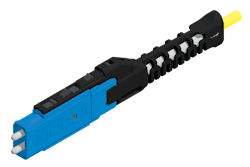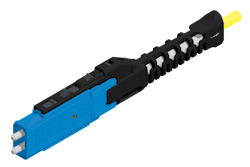High-density connectivity packs fiber into data centers
By Patrick McLaughlin
To accommodate modern networks with extreme density, manufacturers of transceivers have developed ways to increase the number of fiber connections in a given footprint. These transceivers require equally dense fiber connectivity. Recent technology developments have shrunken the amount of real estate occupied by dual-fiber connectors, as well as array-style connectors. This article examines some of the latest fiber-optic connector styles that accommodate today’s highest-density networks.
As we previously reported (“Duplex connectivity emerges on the path to 400G,” February 2020), a group of vendors formed the QSFP-DD (Quad Small Form-factor Pluggable Double Density) multi-source agreement (MSA) Group, with the goal of creating a double-density QSFP transceiver. The group has created several specifications for QSFPs to support Ethernet applications with transmission speeds in the multiple-hundred-gigabits per second. The QSFP-DD Group established specifications for eight lanes that operate at up to 25 Gbits/sec or 50 Gbits/sec—supporting 200 Gbits/sec and 400 Gbits/sec, respectively.
When the QSFP-DD MSA Group released version 5.0 of its hardware specification in 2019, that update included new optical connectors, SN and MDC. The group previously had recognized the CS connector. All three are duplex connectors that are characterized as very small form factor (VSFF).
VSFF duplex connectors
US Conec, which provides the EliMent brand MDC connector, describes it as being “designed for termination of multimode and singlemode fibers up to 2.00 mm in diameter. The MDC connector is manufactured with proven 1.25-mm ferrule technology used in industry-standard LC optical connectors, meeting IEC 61735-1 Grade B insertion loss requirements.”
The company further explained at the time, “Multiple MSAs have defined port-breakout architectures that require duplex optical connector with a smaller footprint than the LC connector. The reduced size of the MDC connector will allow a single-array transceiver to accept multiple MDC patch cables, which are individually accessible directly at the transceiver interface. The format will support four individual MDC cables in a QSFP footprint and two individual MDC cables in an SFP footprint. The increased connector density at the module/panel minimizes hardware size, which leads to reduced capital and operational expense. A 1-rack-unit housing can accommodate 144 fibers with LC duplex connectors and adapters. Using the smaller MDC connector increases the fiber count to 432 in the same 1 RU space.”US Conec has partnered with several fiber-optic connectivity providers to make the MDC connector available. Companies offering MDC connectivity include CommScope, Complete Connect, Corning, Fujikura, Sachsenkabel, Sylex, and tde.
When announcing its collaboration with US Conec in 2020, Corning explained the MDC connector “was designed for breakout application in QSFP-DD, SFP-DD, and OSFP optical transceivers, as well as to change the status quo for patch panel density. Various features implemented in the connector, including simple insertion/extraction using a built-in push/pull boot and simple field-polarity configurability for UPC and APC variants, ensure the MDC platform provides operators with future-ready capacity in a smaller footprint with easier installation.”
Brian Rhoney, Corning Optical Communications’ director of market development, stated, “This VSFF MDC connector enables high-density direct transceiver breakout applications while also enabling three times more patch panel density in structured cabling applications. ;This connector is versatile in a variety of market applications due to its compliance with traditional Telcordia requirements, along with unique features like intuitive push-pull boot and field polarity reversal.”
CommScope, which also began its MDC partnership with US Conec in 2020, commented at the time of the agreement, “The MDC connector is the next step in connector technology, allowing data centers and carrier-based applications to prepare for the network demands of the future. The MDC duplex connector enables the highest achievable connector density by delivering a 3x advantage over a standard LC connector. Manufactured with 1.25-mm ferrule technology, it is designed to support even the most challenging applications such as high-density data center cabling infrastructure and 400G+ breakout transceiver designs.”
Joe Graham, US Conec’s president, added, “The MDC duplex connector ushers in a new era of dual fiber connectivity by delivering unmatched density, simple insertion/extraction, field configurability and optimal carrier-grade performance. The collaborative effort between US Conec and CommScope opens the door to rapid high-volume deployments with leading-edge connector technology to ensure robust supply chain demands are met.”
The other connectors recognized by the QSFP-DD MSA Group, the CS and SN, are products of Senko Advanced Components. Senko introduced the CS nearly five years ago, at which time it explained, “The smaller footprint of CS connectors allows two of them to be fitted within a QSFP-DD module, which LC duplex connectors cannot accomplish. This allows for dual WDM engine design using a 1:4 mux/demux to reach a 2x100-GbE transmission, or 2x200-GbE transmission on a single QSFP-DD transceiver.”
The SN also is a duplex VSFF optical fiber connector. It is targeted at hyperscale, edge, enterprise, and colocation data center interconnect deployment applications. Senko emphasizes the SN increases and improves fiber density (up to 3x) and capacity for existing fiber-optic cassettes and patch panels. The SN supports the implementation of additional fibers without adding new rack units.
Senko also partnered with CommScope in 2020 to produce SN connectors and adapters. When the two companies reached their licensing agreement, CommScope’s vice president of cloud hyperscale solutions John Schmidt commented, “The VSFF SN connector provides individual and independent duplex fiber breakout at a range of quad-style transceivers form factors including the QSFP, QSFP-DD and octal small form pluggable [OSFP]. The SN connector is more efficient, reliable, and scalable than previous small-form-factor connectors like the LC. This is why we feel the SN has a bright future in the cloud hyperscale market space for years to come.”
16-fiber VSFF
Both Senko and US Conec recently introduced high-density array-style connectors that provide 16 fibers in a single row in a smaller footprint than the 16-fiber MPO-style connector. Senko’s SN-MT connector is available in 8-fiber and 16-fiber options. It occupies the same footprint as the SN connector, which achieves a 2.7x density increase compared to a 16-fiber MPO connector, and a 1.3x density compared to a 32-fiber MPO connector. The SN-MT is vertical in orientation, as opposed to the MPO-style connector’s horizontal orientation. The SN-MT can accommodate up to 3456 fiber connections in 1 RU. “This type of high-density solution is perfect for a 1RU-height cop-packaged optics 51.2T switch, which can use 64x SN-MT 16-fiber on the top of the face plate while keeping enough space for the external laser source,” Senko said. “Having the same footprint as the SN connector, 4s SN-MT connectors can fit in QSFP-DD and OSFP footprints, which is a total of 64 fiber connections per transceiver.”
After introducing the SN-MT in early 2021, Senko announced a collaboration with Sumitomo Electric through which the SN-MT will be produced. “We are pleased with this collaboration,” said Senko’s executive vice president Jim Hasegawa. “We can satisfy the multi-vendor requirement of critical components from end-users and we believe this would be a key for the quick adoption of SN-MT products in the market.”
Sumitomo Electric’s general manager of opto connectivity, Shinsuke Niiyama, added, “A high-density optical connectivity solution will be one of the key elements to support increasing data traffic. With SN=MT being the highest-density multifiber connector, using the proven SN connector footprint, we believe we can provide the most practical and valuable solutions to users along with our precision molding technology and know-how.”
US Conec offers the MMC, which accommodates termination of singlemode and multimode fiber cables up to 2.5 mm in diameter. “The MMC connector employs novel TMT ferrule technology harmonized with the MT-16 alignment structure,” US Conec explains. “Individual connector access in the most extremely dense connector environments is easily accomplished using revolutionary DirectConec push-pull boot technology.”
“Next generation architectures are driving the need for optical connectivity solutions that cannot be met with the status quo,” US Conec continues when discussing the MMC’s benefits. “51.2T switching for 500-meter reaches now requires fiber counts exceeding density capacities of the MPO format. MMC applications include co-packaged optics and on-board connectivity, high-bandwidth transceivers, and maximum-density low-loss preterminated cabling infrastructure.”
US Conec and Fujikura recently announced a licensing agreement to develop both the MMC and the MDC connectors. “The new TMT ferrule has now been tooled by both US Conec and Fujikura with full intermateability, eliminating assurance-of-supply concerns,” US Conec said when announcing the agreement with Fujikura. “The TMT ferrule uses the proven alignment structure of the MT-16 ferrule, which is deployed today in MPO-16 connectors and is compatible with standard fiber-optic cabling technology employing 125-µm diameter optical fibers with 250-µm pitch. US Conec’s EliMent MDC connector, a duplex fiber-optic connector with proven 1.25-mm diameter ferrule technology has the same footprint as the MMC and provides three times the density over the duplex LC format while supporting port breakout architectures for emerging transceiver designs. The collaboration to develop and deliver MMC and MDC connectors maximizes the synergy between Fujikura and US Conec while enabling a multi-vendor supply chain.”
We will continue to follow advancements in high-density fiber-optic connectivity and report on what we find.
Patrick McLaughlin is our chief editor.


